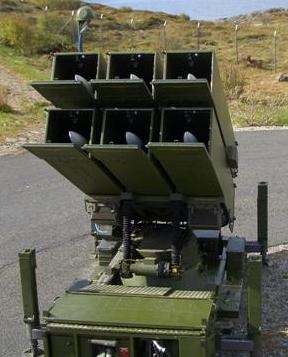| Norwegian Advanced Surface to Air Missile System | |
|---|---|
 NASAMS launcher | |
| Type | Surface-to-air missile system |
| Place of origin | Norway |
| Service history | |
| In service | 1998– |
| Used by | Norway, Spain, Netherlands, Finland, Chile, United States |
| Production history | |
| Designer | Kongsberg Defence & Aerospace and Raytheon |
| Manufacturer | Kongsberg Defence & Aerospace |
NASAMS (Norwegian Advanced Surface to Air Missile System) is a distributed and networked medium to long range air-defence system. NASAMS was the first surface-based application for the AIM-120 AMRAAM (Advanced Medium Range Air-to-Air Missile). The missile itself is named SL-AMRAAM (Surfaced Launched AMRAAM).[1]
Development[]
The Norwegian company Kongsberg Defence & Aerospace teamed up with Raytheon and initiated the NASAMS programme as a cooperative effort for the Royal Norwegian Air Force. The state-of-the-art network-centric air defence system NASAMS was declared fully operational capable in 1998 but had an initial operational capability as early as in 1994/95.
Until the late 1990s the RNoAF ground based air defence solution, also known as the Norwegian Solution (NORSOL), consisted of three different weapon systems; the 40mm Bofors L70 gun (controlled by the Oerlikon Contraves FCS2000 monopulse doppler tracking radar), the laser beam riding RBS 70 MANPADS system and the NASAMS. All three systems were integrated through the ARCS via field wires and radio. The ARCS maintained connection to higher echelons and ensured protection of friendly aircraft while preventing over- and underkill for all subordinate weapon systems. NASAMS capabilities[2] are enhanced by the system's networked and distributed nature.

NASAMS launcher on a Scania 113H truck.
The RNoAF together with KDA is currently running a mid-life update of the NASAMS, called NASAMS II, and the upgraded version was first handed over to RNoAF in mid-2006. The major difference the two versions will be the use of Link 16 on NASAMS II as well as a better ground radar. Full operational capability (FOC) was expected for 2007.
Users[]
NASAMS has been exported to Spain, Finland, and the Netherlands. The government of Chile has also ordered NASAMS. [3] [4][5] Several NASAMS were used to guard air space over Washington, D.C. during the 2005 United States presidential inauguration, and are used to protect air space around the White House.[6][7]
Description[]
NASAMS test firing.
Reloading an AMRAAM missile.
The system integrates US-built AN/TPQ-36A LASR (Low Altitude Surveillance RADAR) 3D radars and AIM-120 AMRAAM missiles with an indigenously developed BMC4I system called FDC, short for Fire Distribution Center. The FDC connected to a TPQ-36A radar forms an "Acquisition Radar and Control System" (ARCS). The missile has a range of up to 25 km. Other sources cite a range of 'over 15 km'.[8] Note that ranges for AAMs are estimated for head-on encounters for fast moving aircraft at an altitude, and the ranges are significantly smaller when the same missiles are launched from stationary ground platforms.
See also[]
Notes[]
- ↑ [1]
- ↑ NASAMS suitability for cruise missile defence
- ↑ "Rapid Fire: 2010-06-22". Defense Industry Daily. 2010. http://www.defenseindustrydaily.com/Rapid-Fire-2010-06-22-06442/. Retrieved 2010-06-25.
- ↑ Air defence contract with the Netherlands
- ↑ Dutch Order NASAMS-SLAMRAAM Air Defense Systems
- ↑ Lund, Elisabeth (2006-02-16). "Norske våpen vokter presidenten" (in Norwegian). Økonomisk Rapport. Archived from the original on 2006-05-19. http://web.archive.org/web/20060519074305/http://www.orapp.no/oversikt/Argang_2006/34877/rapport/35130. Retrieved June 24, 2012.
- ↑ Christensen, Maj. Ola K. (2005-03-08). "The Norwegian Solution!" (in Norwegian). Battle Griffin 2005. Archived from the original on 2005-11-16. http://web.archive.org/web/20051116055704/http://www.mil.no/fol/bg05/start/article.jhtml?articleID=96821. Retrieved June 24, 2012.
- ↑ http://www.defense-update.com/products/n/nasams_300409.html
External links[]
| Wikimedia Commons has media related to NASAMS. |
- Official Norwegian Defence Force website NASAMS page (Norwegian)
- Royal Norwegian Air Force Air and Missile Defence Team Page 1
- Royal Norwegian Air Force Air and Missile Defence Team Page 2
- Royal Norwegian Air Force Home Page
- NASAMS II (fact sheet in (Norwegian)
- Finland acquire NASAMS and radar system for 500 million eur April 28, 2009
The original article can be found at NASAMS and the edit history here.